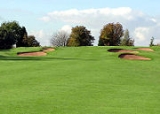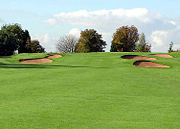
Golf course turf
Encyclopedia

Grass
Grasses, or more technically graminoids, are monocotyledonous, usually herbaceous plants with narrow leaves growing from the base. They include the "true grasses", of the Poaceae family, as well as the sedges and the rushes . The true grasses include cereals, bamboo and the grasses of lawns ...
covering golf course
Golf course
A golf course comprises a series of holes, each consisting of a teeing ground, fairway, rough and other hazards, and a green with a flagstick and cup, all designed for the game of golf. A standard round of golf consists of playing 18 holes, thus most golf courses have this number of holes...
s, which is used as a playing surface in the sport of golf
Golf
Golf is a precision club and ball sport, in which competing players use many types of clubs to hit balls into a series of holes on a golf course using the fewest number of strokes....
. The grass is carefully maintained by a greenskeeper
Greenskeeper
- Basic work description and duties :A professional who maintains a golf course or country club's grounds. This includes all cultural practices along with setting of pins and marking of hazards for regular club play along with tournament play. Greenskeepers work under the direction of the Golf...
to control weeds, insects and to introduce nutrients such as nitrogen fertilization
Fertilizer
Fertilizer is any organic or inorganic material of natural or synthetic origin that is added to a soil to supply one or more plant nutrients essential to the growth of plants. A recent assessment found that about 40 to 60% of crop yields are attributable to commercial fertilizer use...
. The grass is kept at a constant height by mowing
Mower
A mower is a machine for cutting grass or other plants that grow on the ground. Usually mowing is distinguished from reaping, which uses similar implements, but is the traditional term for harvesting grain crops, e.g...
.
Nitrogen application timing
Nitrogen is the nutrient required in greatest amount by turfgrass. During an autumn season, rates of nitrogen (N) application should be lowered to consider previous application’s residual available nitrateNitrate
The nitrate ion is a polyatomic ion with the molecular formula NO and a molecular mass of 62.0049 g/mol. It is the conjugate base of nitric acid, consisting of one central nitrogen atom surrounded by three identically-bonded oxygen atoms in a trigonal planar arrangement. The nitrate ion carries a...
(NO3−) and mineralization
Mineralization (soil)
Mineralization in soil science, is when the chemical compounds in organic matter decompose or are oxidized into plant-accessible forms,. Mineralization is the opposite of immobilization....
(inorganic N), especially if there is substantial organic matter
Organic matter
Organic matter is matter that has come from a once-living organism; is capable of decay, or the product of decay; or is composed of organic compounds...
which releases its supply of sequestered N
In the spring, heavy nitogren applications for the first two months caused changes in color, but the nitrogen response by the grass was not maintained and a decrease in color was found as the growing season progressed. Spring fertilization can increase the tiller numbers of the grass compared to fall fertilization.
In the fall, application of nitrogen fertilizer caused improved color retention and early spring coloration. Year-to-year differences in nitrogen loss during the fall result from differences in temperature and precipitation
Precipitation (meteorology)
In meteorology, precipitation In meteorology, precipitation In meteorology, precipitation (also known as one of the classes of hydrometeors, which are atmospheric water phenomena is any product of the condensation of atmospheric water vapor that falls under gravity. The main forms of precipitation...
. Lower levels of nitrogen loss during fall were found when it was warmer (more plant uptake) and dryer (less loss due to leaching).
The quality and color of turf will increase with nitogen application amount. Both of the high rates created darker green turf throughout the duration of the experiment. There is a positive correlation between high levels of nitrogen fertilizer used on turf and turf quality for any level of wear.
Environmental quality
GroundwaterGroundwater
Groundwater is water located beneath the ground surface in soil pore spaces and in the fractures of rock formations. A unit of rock or an unconsolidated deposit is called an aquifer when it can yield a usable quantity of water. The depth at which soil pore spaces or fractures and voids in rock...
and air quality should be considered when applying fertilizer
Fertilizer
Fertilizer is any organic or inorganic material of natural or synthetic origin that is added to a soil to supply one or more plant nutrients essential to the growth of plants. A recent assessment found that about 40 to 60% of crop yields are attributable to commercial fertilizer use...
and pesticides to turf
Lawn
A lawn is an area of aesthetic and recreational land planted with grasses or other durable plants, which usually are maintained at a low and consistent height. Low ornamental meadows in natural landscaping styles are a contemporary option of a lawn...
.
Fate of nitrogen
Turf growth at the time of nitogen application has an impact on nitrateNitrate
The nitrate ion is a polyatomic ion with the molecular formula NO and a molecular mass of 62.0049 g/mol. It is the conjugate base of nitric acid, consisting of one central nitrogen atom surrounded by three identically-bonded oxygen atoms in a trigonal planar arrangement. The nitrate ion carries a...
(NO3) leaching risk. For example, grass uptook more N during active growth while uptake was limited in newly seeded turf. In another study, nitrogen applied after 15 September (of an northern-hemisphere autumn) caused relatively little plant growth, resulting in increased NO3 - N concentration in percolate water
Areas made of sod
Sod
Sod or turf is grass and the part of the soil beneath it held together by the roots, or a piece of thin material.The term sod may be used to mean turf grown and cut specifically for the establishment of lawns...
undergo greater leaching
Leaching (agriculture)
In agriculture, leaching refers to the loss of water-soluble plant nutrients from the soil, due to rain and irrigation. Soil structure, crop planting, type and application rates of fertilizers, and other factors are taken into account to avoid excessive nutrient loss.Leaching may also refer to ...
than seeded turf plots. They attributed these differences to less root development in sod which resulted in less uptake of N by the plants. They also found that deep- rather than shallow-rooted grasses absorbed nitrogen more effectively. Additionally, the authors found that nitrogen uptake for loamy sand was greater than a sandy loam because the turf rooting systems were denser in the loam sand.
A highly soluble fertilizer, containing nitrogen in its nitrate form, such as ammonium nitrate, can create leaching three to seven times greater than United States Environmental Protection Agency (EPA) limits of (10 ppm) NO3-N during a time of ten to twenty-five days following nitrogen application. Hummel and Waddington, 2001, found that a slow release nitrogen fertilizer application could provide nitogen over a long duration and keep nitogen leaching and volatilization losses to a minimum. A further study demonstrated that after fertilizer application, nitrogen losses exceeded EPA limits.
Photoperiod (the length of daylight) affects overall plant uptake
Mineral uptake
In plants, mineral uptake is the process in which minerals enter the cellular material, typically following the same pathway as water. The most normal entrance portal for mineral uptake is through plant roots. Some mineral ions diffuse in-between the cells...
. When the length of daylight gets shorter, grass undergoes less photosynthesis
Photosynthesis
Photosynthesis is a chemical process that converts carbon dioxide into organic compounds, especially sugars, using the energy from sunlight. Photosynthesis occurs in plants, algae, and many species of bacteria, but not in archaea. Photosynthetic organisms are called photoautotrophs, since they can...
and uptakes less nitrogen. To prepare the surface for the following year, high levels of nitrogen application need to be undertaken at the end of the growing season (such as the southern United States) and increase the risk of nitrate leaching. For example, greater water percolate concentrations of NO3 - N resulted from a late autumn application programme during a New England experiment
See also
- Golf courseGolf courseA golf course comprises a series of holes, each consisting of a teeing ground, fairway, rough and other hazards, and a green with a flagstick and cup, all designed for the game of golf. A standard round of golf consists of playing 18 holes, thus most golf courses have this number of holes...
, design and terminology - RolawnRolawnRolawn Limited has become Europe's largest producer of lawn turf. Based in the North of England in the county of North Yorkshire, Rolawn is a widely known name in the UK turf industry, partly because of the quantity of turf that the company is able to produce on a regular basis and partly because...
, suppliers of golf course turf

